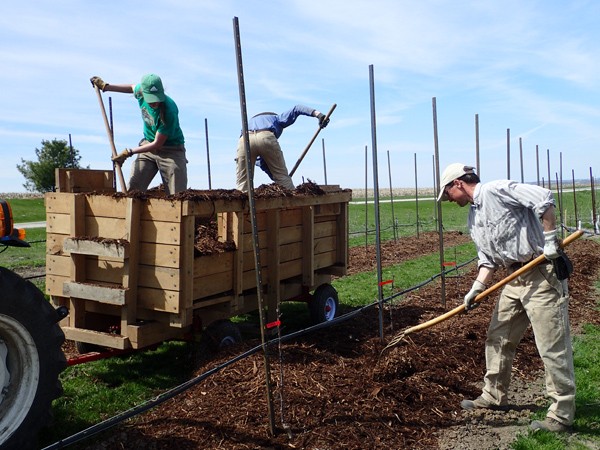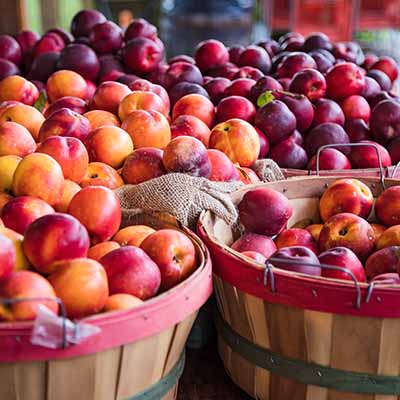The following is an excerpt from The Holistic Orchard by Michael Phillips, available now from Chelsea Green Publishing.
The best time to plant a tree was twenty years ago; the second-best time is now. — Chinese proverb
Fruit trees and berries should be planted as early in the spring as possible after the soil has dried out sufficiently. Soil preparation the year before helps in getting nursery stock planted that much earlier. Cold soil temperatures will promote the development of calluses at the tips of any torn roots. Normal spring rains will then settle the soil around the roots before leaf growth occurs. Catch this timing right and your trees will slide into full gear with nary a backward look.
Planting delays do happen, however, and in that case orders from the nursery can be tucked away in moist wood shavings or the like in a cool place for a week or two. If it’s going to be longer (you’re off to the Bahamas!) bareroot plants should be heeled in the garden until proper planting holes can be dug. Trees planted after leaves have started to grow will experience transplant shock, in part because feeder root growth has begun. This can potentially stunt both the upper tree and root development, so don’t wait too long. Heavy pruning can help, and reliable irrigation is better—but respecting tree dynamics is the best strategy of all.
Growers in Zone 6 and south should take advantage of fall planting. The root growth that takes place in mild winters gets the young tree established and raring to go by spring. Fully dormant trees can be transplanted from mid-November through December. Larger two-year nursery trees suffer less transplant shock when fall-planted and thus retain a head start on one-year whips. Roots continue to grow even though tops are dormant in regions where soil temperatures remain above 40°F (4°C). Damage to the roots is more likely to occur in northern zones from the frost-heaving of recently disturbed soil. Mulching a new tree after the ground freezes can alleviate this concern . . . just be sure to wrap tender young trunks to protect them from voles.
Trees can be purchased directly from nurseries as bareroot stock or already potted up at a local garden center. You might even be able to obtain trees of bearing age from a local orchardist (admittedly, a big- bucks proposition suitable mainly for those without patience). I recommend the bareroot option hands down: Young whips do not go through transplant shock like more sizable trees that have been waiting, rootbound, in bundled soil for a year or more. People tempted by the bigger tree right there that very day frequently end up making a less-than-stellar variety choice, transplanting a tree that’s in full leaf (definitely not recommended), and then compromising future growth for years to come by not loosening up the roots so they can reach out beyond the matted disaster often found in the pot. Repeat after me: I will plan ahead and arrange for bareroot stock to plant out at the right time.

Prior to planting, you should never allow the roots of any plant to dry out. Soaking the roots in a bucket of seaweed solution will help reduce transplant stress; do this the night before planting and pledge not to leave roots soaking for more than twenty-four hours. A relatively calm, cloudy day is preferable to a sunny, windy day for planting. Be sure each tree and fruiting shrub is individually labeled to identify who’s who in the planting plan. Brambles often come bundled in tens for planting out in beds. Digging holes ahead of time for a planting session can be more efficient than a “dig then plant, dig then plant” routine.
A proper hole The tree hole obviously needs to be large enough to accommodate the root system. However, digging a hole significantly larger than that preps the immediate soil zone for root outreach. A 3-foot-diameter hole generally fits the bill. I will trench out a channel for an excessively long root rather than curl it in toward the trunk. Loosening the subsoil in the bottom of a 16- to 20-inch-deep hole provides additional leeway in setting the height of the graft union aboveground. A buried graft union will eventually establish its own roots, which override the desired dwarfing effect of clonal rootstock. I aim to keep the graft union 4 inches above the soil line, planting only slightly deeper than the tree may have grown in the nursery. Keep in mind that the settling of looser soils may bring the graft union down another inch or so. Trees on seedling roots are the one exception: The graft union can be buried if you wish to encourage self-rooting of the scion cultivar.
The tree hole obviously needs to be large enough to accommodate the root system. However, digging a hole significantly larger than that preps the immediate soil zone for root outreach. A 3-foot-diameter hole generally fits the bill. I will trench out a channel for an excessively long root rather than curl it in toward the trunk. Loosening the subsoil in the bottom of a 16- to 20-inch-deep hole provides additional leeway in setting the height of the graft union aboveground. A buried graft union will eventually establish its own roots, which override the desired dwarfing effect of clonal rootstock. I aim to keep the graft union 4 inches above the soil line, planting only slightly deeper than the tree may have grown in the nursery. Keep in mind that the settling of looser soils may bring the graft union down another inch or so. Trees on seedling roots are the one exception: The graft union can be buried if you wish to encourage self-rooting of the scion cultivar.
Do not mix massive amounts of compost with the soil in the planting hole. The roots will soon extend much farther into the surrounding earth for long-term sustenance. A super-enriched planting hole gives roots little reason to leave the home base. I prefer to backfill the tree only with the soil that came out of the hole, with the more friable topsoil placed against the roots and the subsoil used to finish filling the hole. Tree nutrition in the years ahead will come from above in the form of orchard compost and ramial wood chips to build that desirable fungal duff, where 90 percent of the feeder roots will be found. Extension advice to load young fruit plantings up on nitrate fertilizers for the first several years will work against the fungal connection we seek for long-term tree health.
Roughly serrating the sides of a hole dug in heavy soil with a digging fork helps fracture a too-smooth clay finish. Growing roots need to readily penetrate into the surrounding soil; otherwise they may circle around the glazed bowl that can inadvertently result from clay particle adhesion caused by digging the hole. Piling good soil to one side of the planting hole and less loamy subsoil to another side as you dig allows you to systematically plant without compacting the turned earth as you maneuver about. I sprinkle a pound of rock phosphate (for early root development) and the same amount of Azomite (for trace nutrients) onto these soil piles and into the tree hole itself, stirring all together in the planting process.
Berries are more straightforward (not having been grafted in the first place), because the soil line evident from nursery days marks the very goal for planting day. Preparing the bed during the previous year makes planting a quick task, particularly for brambles. Use a hoe to create a deep-enough planting furrow, then line out cane stock at the recommended spacing.
Trees and fruiting bushes planted in containers will require much more frequent watering and feeding with compost tea and herbal brews. Porous-walled pots will lose moisture rapidly compared with a thick- walled tub or whiskey barrel. Drainage holes are a must to prevent roots from sitting in standing water; a gravel layer at the very bottom is strongly suggested to facilitate this drainage. Suggested soil mix for potting up: equal parts compost, perlite, peat moss, and decomposing forest leaf litter. Ramial mulch atop this soil is the right biological touch. Containerized trees eventually get severely rootbound but can be a fun novelty while the plants thrive.


 It is challenging to manage apple pests with organic methods. Fortunately, this is one part of orcharding where it’s possible to improve over time. It’s hard to change varieties or tree spacing in an established orchard, but you can fine tune your pest management practices from year to year and learn as you go.
It is challenging to manage apple pests with organic methods. Fortunately, this is one part of orcharding where it’s possible to improve over time. It’s hard to change varieties or tree spacing in an established orchard, but you can fine tune your pest management practices from year to year and learn as you go. 
 Diversify your boxes and bouquets with apples and branches
Diversify your boxes and bouquets with apples and branches



